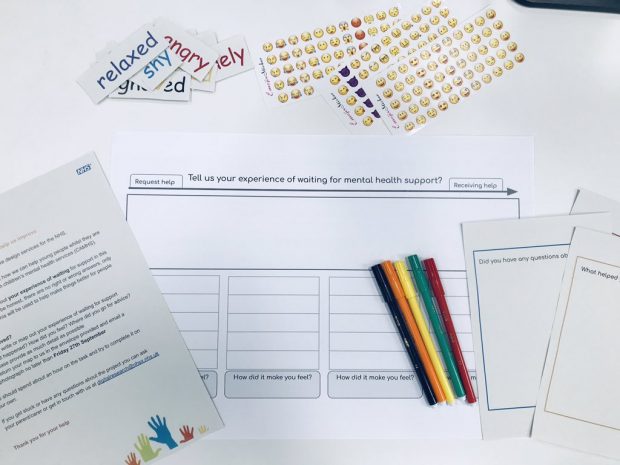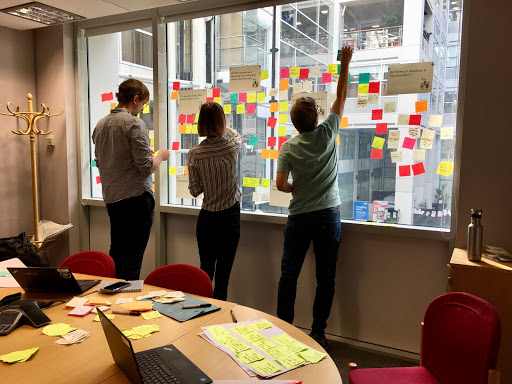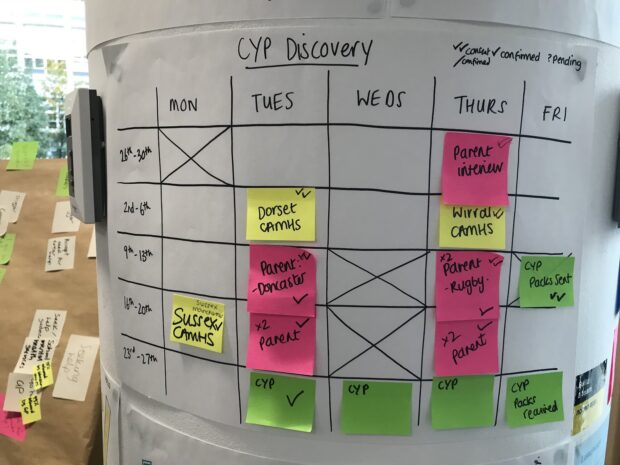
As a researcher, it can sometimes feel like a challenge getting the whole team on board with user research and practising it as a ‘team sport’.
I’ve recently been working on a discovery project with a small multidisciplinary team. The problem we set out to discover was:
“What are the opportunities to support children and young people in preparation for their first or subsequent contact from mental health services?”
This post is about how the team benefited from everyone being involved in user research.
Defining our users
One of the first activities we did as a team was to split the problem statement into a set of high level research questions we wanted the discovery to answer. This helped us to decide which users we would need to speak to. In the first week, the team held a session to:
- Define who our users are
- List all the factors that could affect how they use the service
- Agree approaches to recruitment
I then pulled together a detailed recruitment screener that was shared around the team.

Deciding our research methods
Next the whole team brainstormed ideas of how we could find answers to the discovery questions. This was a fun way of thinking bigger and challenging traditional research methods. Although the whole team contributed, the research plan was guided by the user researcher to make sure methods were safe and feasible in the time available.
Our research plan included:
- Round 1: Site visits to children and young people’s mental health services
- Round 2: Parent interviews (home visits/remote)
- Round 3: Children and young people’s experience mapping task and follow-ups
At the start of each round, we held a group session to decide what we wanted to learn. I took away the team questions to develop a set of interview questions for the discussion guide.
Conducting research
At least one team member accompanied the user researcher to every session (as a note-taker). This worked well for making sure we captured enough detail, collectively built empathy and had a shared understanding of user’s needs, experiences and motivations. Pairing up was important when entering participant’s homes and for follow-up support given the nature of this research.
If your team are taking notes, make sure they are writing what the participant says, not their interpretation of it. It’s a good idea to reiterate with a guide like this one. I also take notes myself, mostly as prompts to go back through recordings and find interesting quotes we might have missed! Keep all notes safely stored in one place ready for analysis.
Analysing research
At the end of each round, we brought all individual notes (on post-its) to team analysis. We stuck up the research questions for that round, swapped notes and grouped them next to questions they related to.
This worked well for team members to learn about what happened in other sessions and to reduce bias. We all had the opportunity to share and learn about every session.
After grouping notes into themes, we sat down and individually wrote the top 6 insights we felt came out of that round. These were discussed as a group and I consolidated them into a set of high level findings to share.

Sharing learnings
Alongside user research, the team read reports and literature, analysed data and met with suppliers to find answers to our discovery questions. Every Friday we would come together to share what we found. We also held a shared understanding day at the very end of the discovery to expose everything we had learnt and prioritise our findings.
This was good for exposing anything new, challenging each other's assumptions and making sure we all agreed. Findings were voted on and generated a set of How Might We statements to frame the next stage of our design process.
Practical tips
- Create a research schedule that is visible to the team with an easy way to volunteer as note-taker
- Send out invites in advance for team sessions and the research itself
- Give everyone the chance to input into research questions (even remotely)
- Bring at least one note-taker to every session so that the team is exposed to live research
- Do individual planning, team prep and capturing quotes for extra detail
- Make sure you have enough time alloted for shared understanding- this is just as important as finding out more stuff
- Steer the team in the right direction and take ownership for the quality and safety of the research
It’s worth noting that this team was particularly willing and available to engage in user research. This isn’t always the case and the approach will need to be tailored to the needs of the team.
Having said that, by involving everyone in the research I got the chance to see other’s perspectives and their interpretation of the sessions. It definitely made the project run smoothly and more enjoyable too!
To find out what we did you can read our weeknotes. For questions, contact the author sophie.rankin@nhsx.nhs.uk
Leave a comment